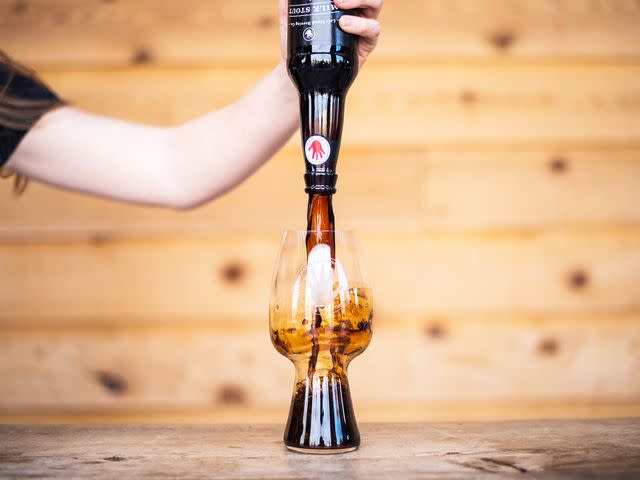Nitro Beer, Explained
It's all about the bubbles.
Guinness famously developed and popularized the process of infusing beer with nitrogen gas — a marriage that subtly alters a beer’s aroma and flavor while lending it a silky, creamy mouthfeel. How does nitrogen do this?
It’s all about the bubbles.
Most traditional beers are carbonated, a process that can occur naturally during fermentation. As yeast converts sugar to alcohol, it also produces carbon dioxide. That carbon dioxide — if the brewer chooses to trap it — infuses a beer with tiny gas bubbles that give it a lively, prickly texture akin to soda or seltzer water. Brewers can also add carbonation during the bottling or packaging process.

Most nitro beers are mildly carbonated. But the addition of nitrogen — an insoluble gas that forms smaller, more profuse bubbles than carbon dioxide — gives beer a smoother texture.
For a long time, craft brewers tended to eschew nitrogen infusion. Part of that was the challenge of incorporating the gas into their brews — either in the can, or in barroom taps. Many also felt nitro-infused beers — especially floral, citrusy, hoppy brews like pale ales — lost a lot more than they gained. Not long ago, the only nitro beers you could find — on tap, or in cans — were Guinness and Left Hand Milk Stout.
Related: America's 50 Best Stouts
All that’s started to change. Even Budweiser is catching on. While some hardcore craft fans still consider nitro-infusion anathema, others have come around to the idea that texture — along with aroma and taste — plays a big role in a drinker’s enjoyment.
While most nitro beers are still only available on tap, there are now a handful of good options available in cans or bottles. Here are six of them.
Guinness Draft by Guinness & Co.
Gotta give credit where credit’s due. And when it comes to nitro beer, the originator deserves a prominent place on the list. If you didn’t realize the nitrogen in your pint (or bottle or can) of Guinness was the cause of those wonderful, dusky, downward-flowing bubbles, now you know. Sip and enjoy the frothy goodness.
Milk Stout Nitro by Left Hand Brewing Co.

While Guinness was the pioneer, Colorado’s Left Hand Brewing has taken nitro beer and run with it. The brewery offers both nitro and non-nitro versions of its popular milk stout. Sampling them side by side is a great way to understand how nitrogen changes a beer. Left Hand also sells a half dozen other solid nitro brews. Their Hard Wired Nitro is excellent.
Nitro Vanilla Porter by Breckenridge Brewery

Aromas of dark malt, cocoa, and cola waft out of this black-amber beer from Colorado’s Breckenridge, and those same notes come through in your mouth. While it looks thick and rich, it’s a surprisingly light-bodied (and refreshing) brew.
Related: 24 Essential Colorado Breweries
Polygamy Nitro Porter by Wasatch Brewery
A great beer from a great under-the-radar brewery, Wasatch’s Polygamy Nitro is a smooth, malty bone-warmer. Lots of chocolate and bread on the nose — clearly, there’s a profile brewers believe works best with nitro beer — with some mildly sweet hits coming through on the palate.
Red Velvet by Ballast Point Brewing Co.
This amber-hued oatmeal stout from San Diego-based Ballast Point is modeled after its namesake cake. It gets its color — and some of its earthy flavors — from beets incorporated during the brewing process. There’s a lot going on here, but spice and malty sweetness are dominant. It’s a wildly unconventional beer and worth seeking out.
Nitro Coffee Stout by Sam Adams (Boston Beer Co.)

If you like coffee and you like stout, you’re already sold. And while there are plenty of excellent coffee stouts out there — Sierra Nevada makes a great one — the incorporation of nitrogen takes this Sam Adams offering to another level.
For more Food & Wine news, make sure to sign up for our newsletter!
Read the original article on Food & Wine.
